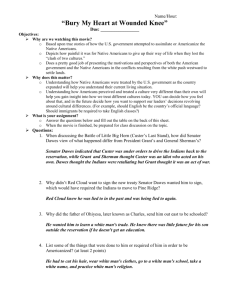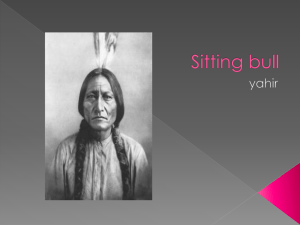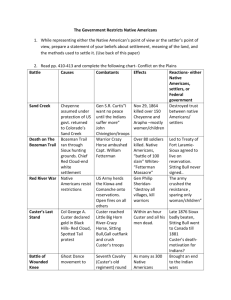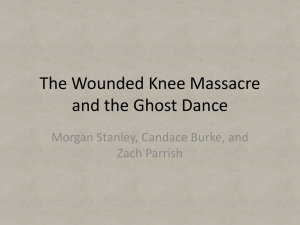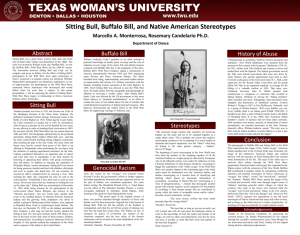1. When discussing the Battle of Little Big Horn (Custer`s Last Stand
advertisement
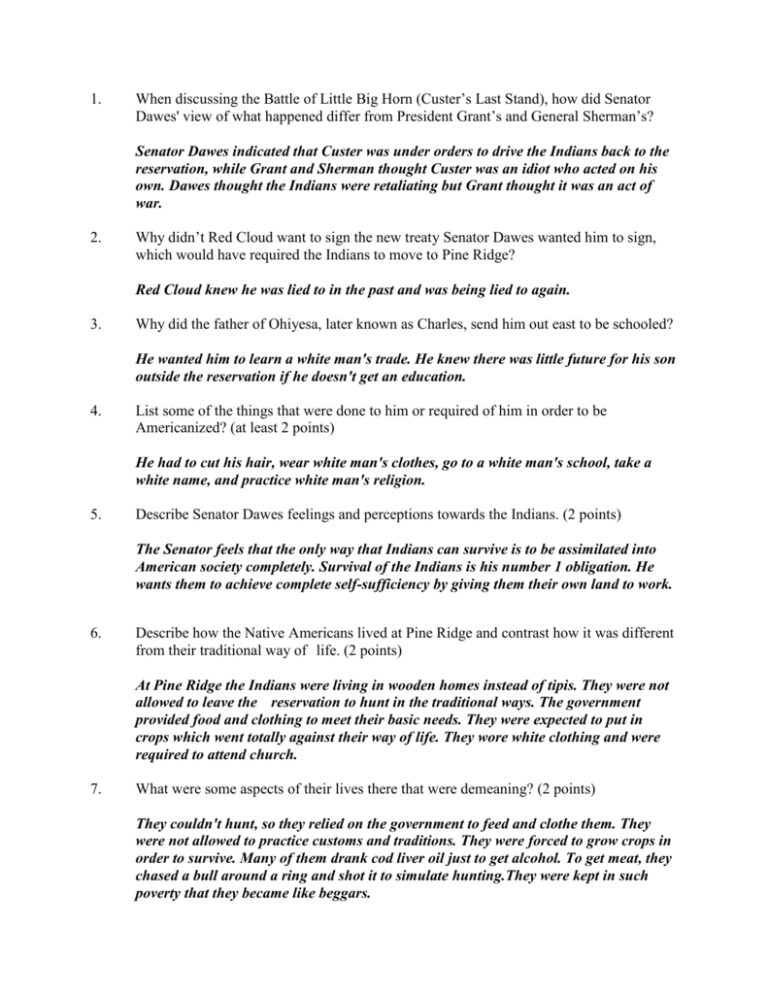
1. When discussing the Battle of Little Big Horn (Custer’s Last Stand), how did Senator Dawes' view of what happened differ from President Grant’s and General Sherman’s? Senator Dawes indicated that Custer was under orders to drive the Indians back to the reservation, while Grant and Sherman thought Custer was an idiot who acted on his own. Dawes thought the Indians were retaliating but Grant thought it was an act of war. 2. Why didn’t Red Cloud want to sign the new treaty Senator Dawes wanted him to sign, which would have required the Indians to move to Pine Ridge? Red Cloud knew he was lied to in the past and was being lied to again. 3. Why did the father of Ohiyesa, later known as Charles, send him out east to be schooled? He wanted him to learn a white man's trade. He knew there was little future for his son outside the reservation if he doesn't get an education. 4. List some of the things that were done to him or required of him in order to be Americanized? (at least 2 points) He had to cut his hair, wear white man's clothes, go to a white man's school, take a white name, and practice white man's religion. 5. Describe Senator Dawes feelings and perceptions towards the Indians. (2 points) The Senator feels that the only way that Indians can survive is to be assimilated into American society completely. Survival of the Indians is his number 1 obligation. He wants them to achieve complete self-sufficiency by giving them their own land to work. 6. Describe how the Native Americans lived at Pine Ridge and contrast how it was different from their traditional way of life. (2 points) At Pine Ridge the Indians were living in wooden homes instead of tipis. They were not allowed to leave the reservation to hunt in the traditional ways. The government provided food and clothing to meet their basic needs. They were expected to put in crops which went totally against their way of life. They wore white clothing and were required to attend church. 7. What were some aspects of their lives there that were demeaning? (2 points) They couldn't hunt, so they relied on the government to feed and clothe them. They were not allowed to practice customs and traditions. They were forced to grow crops in order to survive. Many of them drank cod liver oil just to get alcohol. To get meat, they chased a bull around a ring and shot it to simulate hunting.They were kept in such poverty that they became like beggars. 8. Were there aspects that were better than their traditional lives? In what way? They no longer lived in tipis which kept them out of the elements. They were educated to help them acquire skills necessary to survive off the reservation. 9. In what ways did Sitting Bull resist adopting the “white man’s” life? (2 points) Sitting Bull refused to live on reservations for a time. He left the Dakota's and took his people to Canada to live. He would not grow crops when he was living on the reservation. He did not want ration stamps, and he wanted to pass out supplies to his people himself. He allowed his people to dance the Ghost Dance. 10. Why do you think it mattered to the U.S. government whether or not Sitting Bull assimilated? Explain. (2 points) It probably mattered to the government because Sitting Bull was the respected leader of the Lakota Sioux people. If Sitting Bull were to embrace the idea of assimilation, he could persuade other members of the tribe to do so also. On the other hand, if Sitting Bull didn't assimilate, others would follow that example, too. 11. Describe some of the conflicts Charles felt about being Americanized and being a Native American. (2 points) One could see the torment he felt just in selecting his white name Charles. He held on to his past by keeping the feather from Little Big Horn. His ability to treat disease as a doctor and his native roots tormented him as the people were infected with white man's diseases and were dying. He was caught in a world between being a native person and a white person and didn't know where he really belonged. 12. How did the Canadians feel about the Indians? The Canadians welcomed the Indians to Canada and even allowed them to hunt as long as they did not use Canada as a means to invade in the U.S. or infringe on the hunting grounds of other tribes. The Canadians felt the U.S. government was responsible for its troubles with Indians. Land Religion Treaties Describe the Describe Sitting General's view Bulls' view of: of: He says that the Indians came These are the from other lands lands my people and took land lived on before from other you came, given tribes, which is to us by Wankan no different than Tanka. People what is cannot own land. happening to them know. He says that Indians can't use He says that the religion to Black Hills are explain their their sacred desire for the hunting lands. Black Hills. Sitting Bull does Sitting Bull not reconginize should honor the the other chiefs or treaties like the the treaties they rest of the tribes. agreed to. Wars Miles tells Sitting Bull that his tribe had been fighting other Indians for hundreds of years the before white man came. Sitting Bull did not want to fight. He just wanted the soldiers to leave the land, but if he had to, he would fight.
